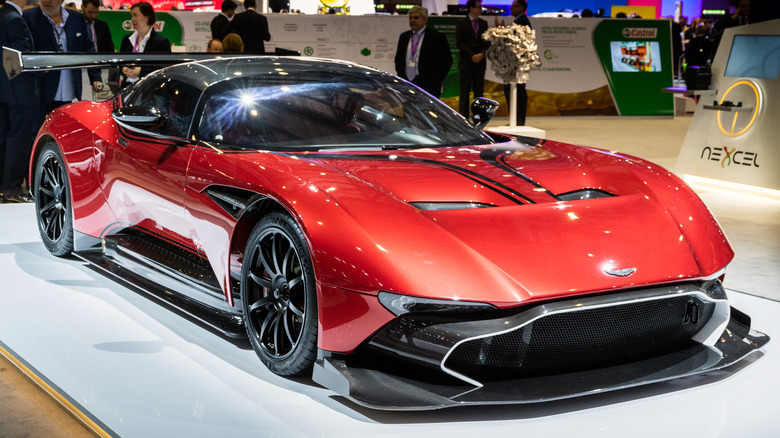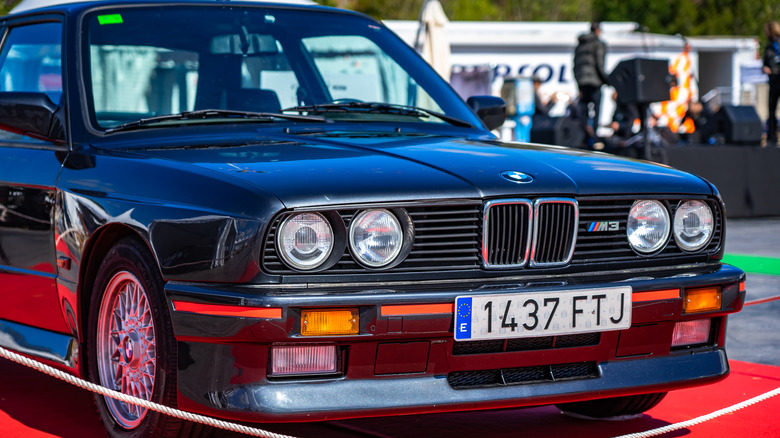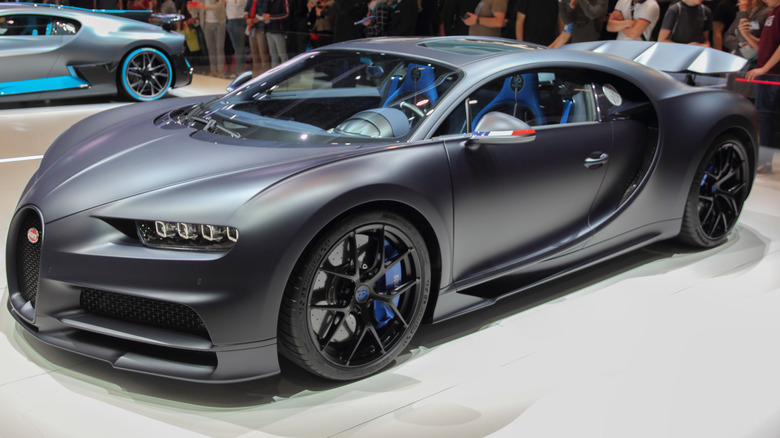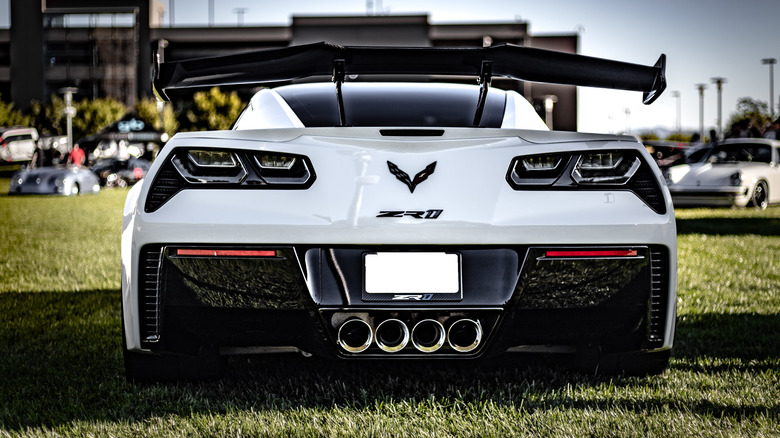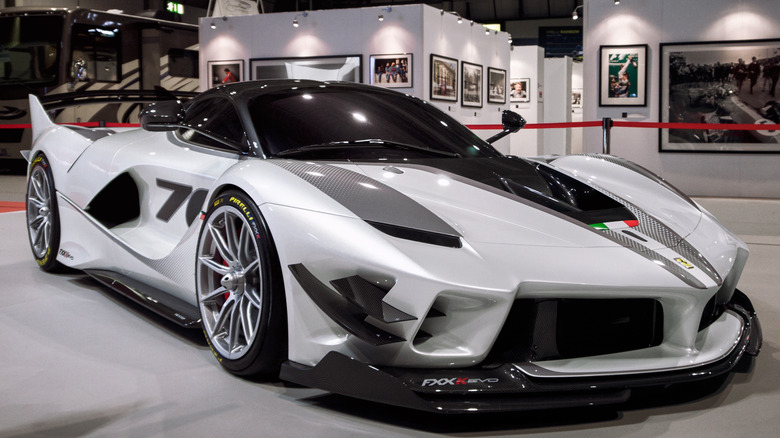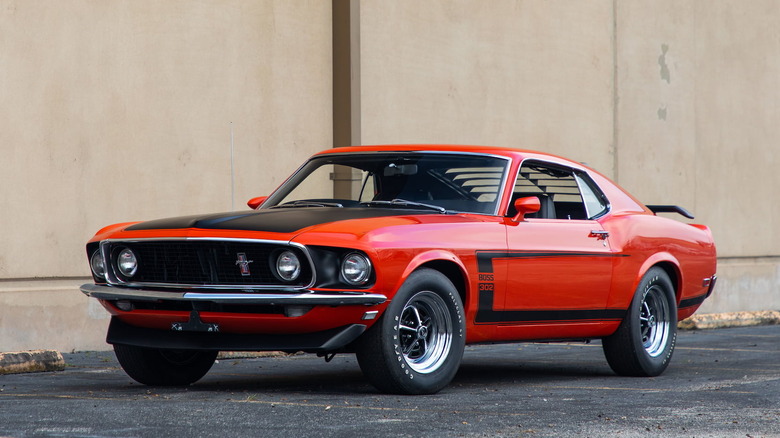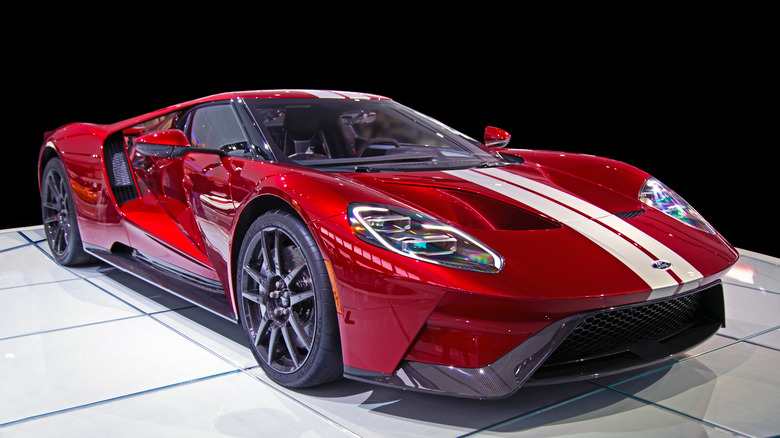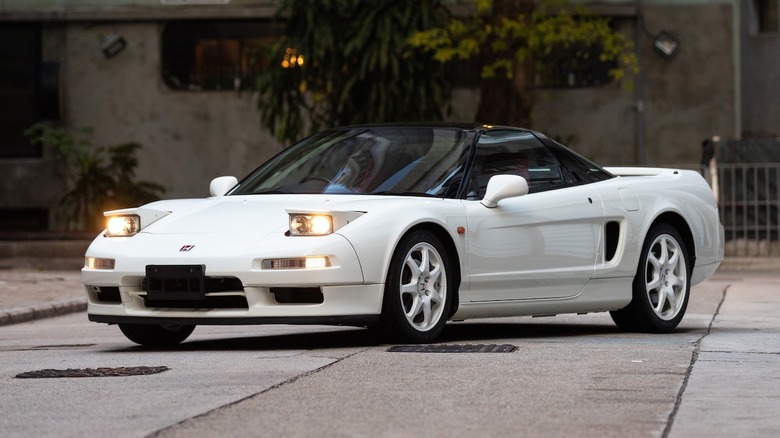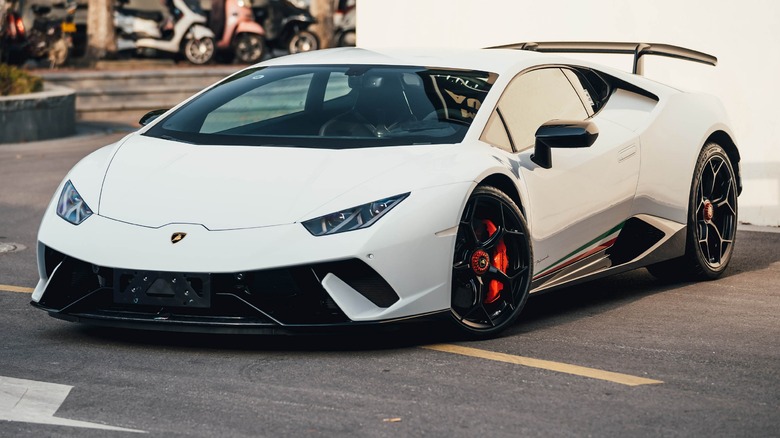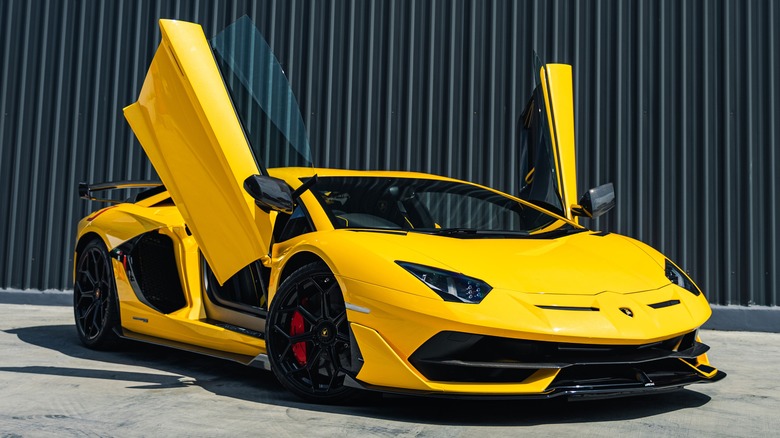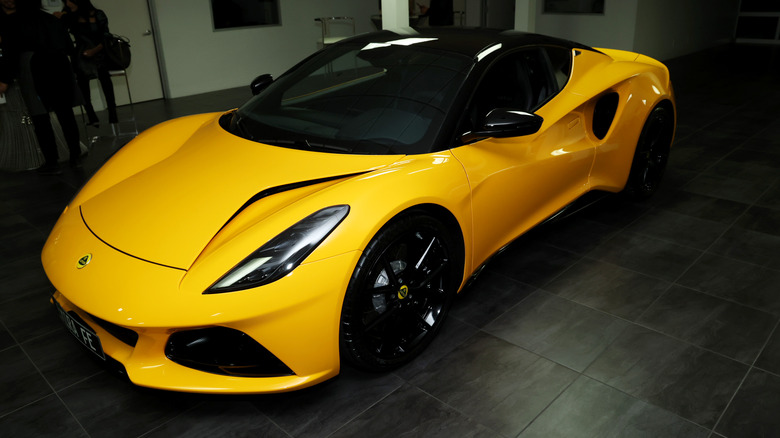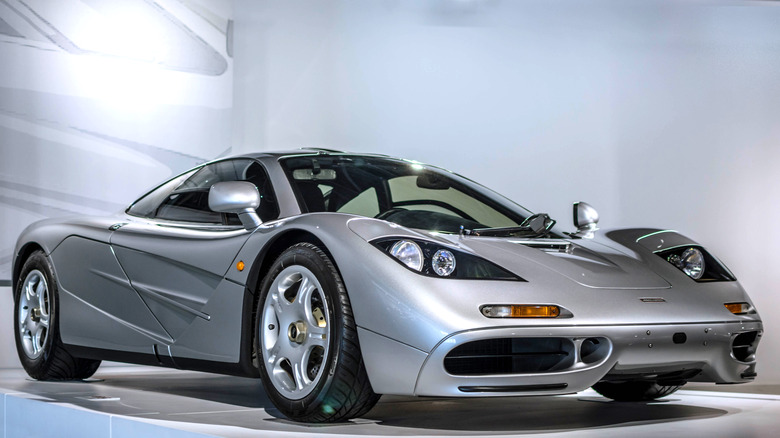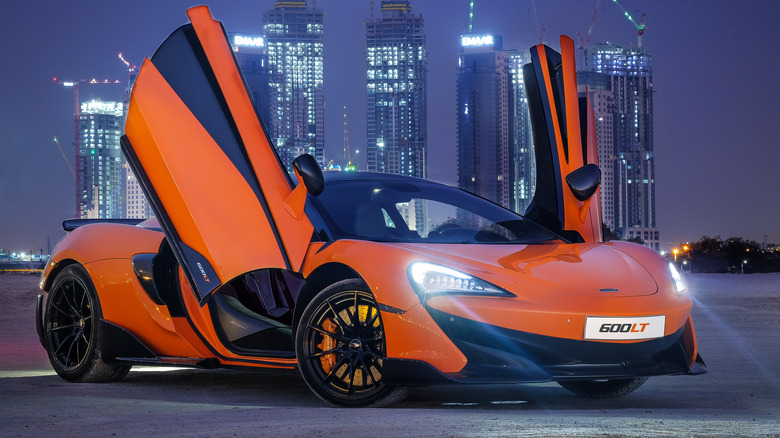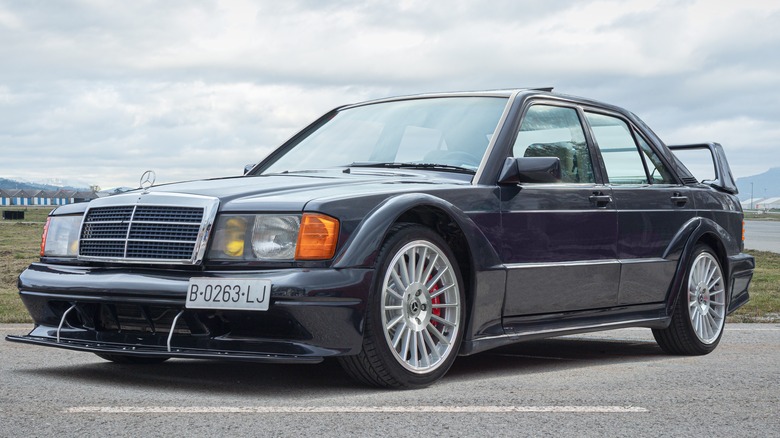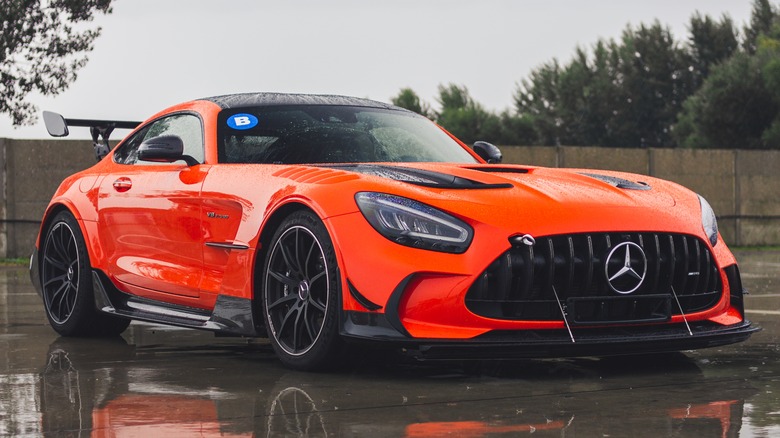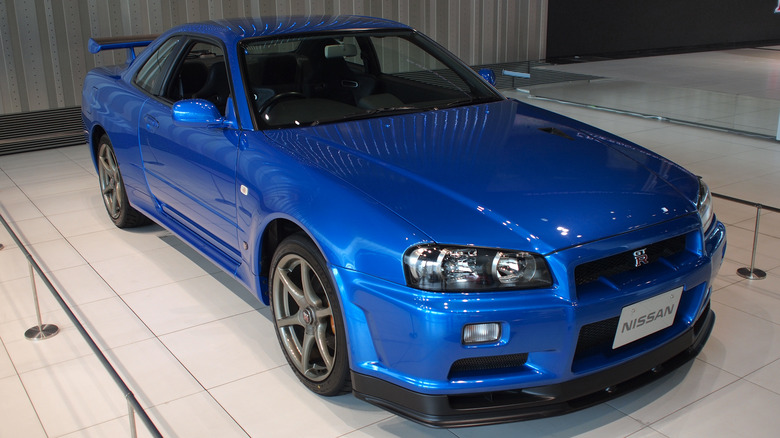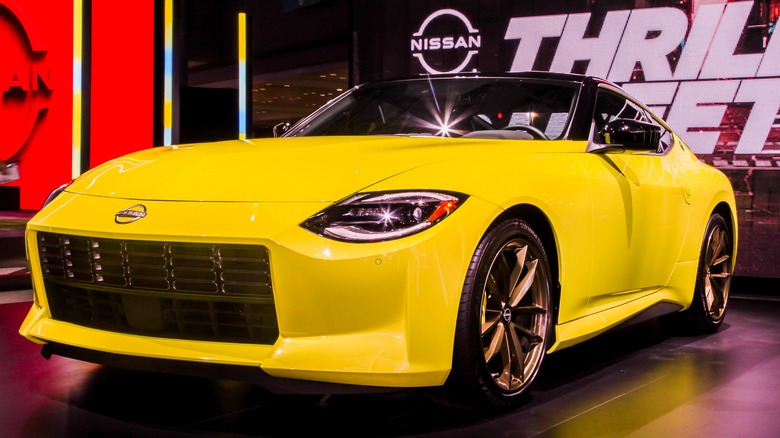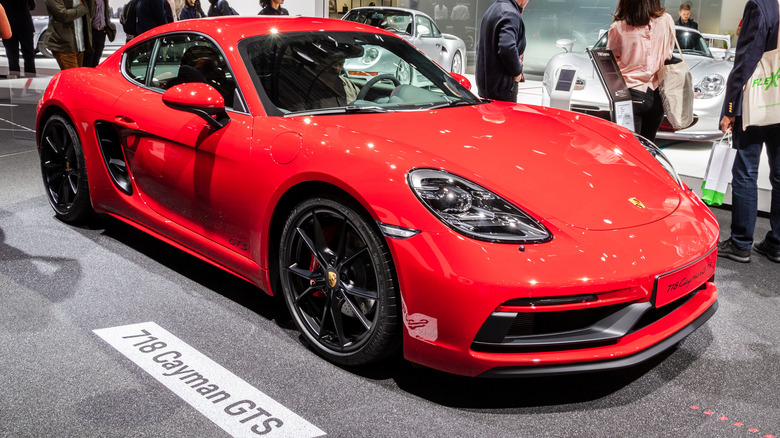We're Most Excited To Drive These Cars In Need For Speed Unbound
The "Need For Speed" franchise needs no introduction. While countless versions have enticed avid gamers, it's the latest iteration — "Need For Speed Unbound" — Electronic Arts' latest car racing video game is just around the corner, with an official release on December 2, 2022.
As with any NFS game, cars play a pivotal role, and things are no different in "Need For Speed Unbound." According to EA (Electronic Arts), the roster includes 143 cars, all of which—in typical NFS fashion—can be modified with custom vinyls, rims, body kits, and so on.
Just about every mainstream carmaker you can think of is part of the game. Being able to virtually experience them will be nothing short of exciting. Especially considering how "NFS Unbound" is set to deliver next-level graphic performance and immersive gameplay. Per creative director Kieran Crimmins, "the physics will run at a high frame rate, offering more control and nuance to the physical movement of the cars." (via IGN)
With Criterion Games—famed for developing previous NFS hits like Hot Pursuit, Most Wanted, and Rivals—involved, it's safe to assume the latest "Need For Speed" edition will be an absolute winner. We can't wait for its release and try out some of these cars.
2016 Aston Martin Vulcan
Named in honor of Britain's cold war bomber (via Road and Track), the V12-powered Vulcan hypercar is limited to just 24 units worldwide and is loosely based on the brand's previous special, the Aston Martin One-77. However, unlike its road-going predecessor, the Aston Martin Vulcan is track-only, evident from its humungous rear wing and GT3-spec front splitter.
The 7.0L V12 inside this track toy comes in three states of tune. Power mode 1 gets you 550 horsepower, mode 2 unlocks 675 horsepower, and mode 3 will unleash the full 820 horsepower. Torque produced stands at 575 lb-ft and is transmitted to the rear wheels via a 6-speed automated manual gearbox. The Aston Martin Vulcan can hit 0-60 mph in 2.9 seconds and has a top speed of 208 mph. Interestingly, the car can generate its own body weight (2,976 lbs) in downforce at Vmax, rendering it a theoretical possibility of driving upside down (via Top Gear).
You also get Brembo race-spec brakes along with fully adjustable independent suspension. As you can tell, driving it should be an absolute hoot. If you max out the performance, this Aston Martin Vulcan could very well be the most exciting bit of hardware in the "NFS Unbound" roster.
1988 BMW M3 Evolution II
The E30 M3, a mix-mash of alphanumerics that signify nothing to the average Joe but everything to a proper gear nut, gave BMW the title of being the "Ultimate Driving Machine" The BMW M3, especially the first ever iteration—generation E30, was a true homologation special with racing pedigree.
The E30 M3 was a proper race car for the road (via Motor Trend). There was little in the name of amenities, and the normal creature comforts you're used to in a 3-series were quite frankly non-existent. Between the regular 3-series of the time, which the M3 was loosely based on, shared components were limited to just the hood, roof, and inner door panels (via Car and Driver).
With the E30 M3 Evolution, things took a spicy turn. Power was up from the regular M3's 192 horsepower, to 212 horsepower. More importantly, the car featured thinner rear and side window glass, a lighter trunk lid, a deeper front splitter, a rear spoiler, and larger wheels. The Evolution II was basically a non-catalytic converter version of the E30 M3 Evolution. Thanks to that little modification, this top-tier Beemer now made close to 220 horsepower from its 2.3L inline-four.
2017 Bugatti Chiron Sport
The Chiron was shown to the public in 2016 as a successor to the Bugatti Veyron. The engine alone in a Bugatti Chiron, or any Bugatti for that matter, deserves to be on a mantel. The 8.0L W16 quad-turbocharged motor is a masterpiece: not only is it incredibly complex, but engineers managed to package the entirety of this monstrous engine inside a relatively small shell.
Power figures are astounding, with the Bugatti Chiron pumping out 1,479 horsepower and 1,180 lb-ft of torque. The Chiron Sport, on the other hand, is an all-wheel-drive (AWD) brute that's a bit spicier than the Chiron. Right off the bat, the major visual difference between a regular Chiron and the Chiron Sport is the four individual exhaust tips.
The Sport also boasts more responsive steering, a stiffer chassis, and a rear differential with torque vectoring at speeds of up to 75 mph (via Carbuzz). Plus, at 4,359 pounds, the Chiron Sport is 40 pounds (or around 1 percent) lighter than the regular Chiron. Performance is roughly the same, with 0-60 happening in 2.4 seconds, 0-100 mph in 4.4 seconds, and a top speed limited to 261 mph.
2019 Chevrolet Corvette ZR1
The legacy of the Corvette spans eight generations, including the most recent mid-engined design. The Vette in this discussion has more in common with its '60s cousin than the modern C8 Corvette. This here is the 755 horsepower Corvette ZR1, the most powerful production Chevrolet in existence (via Motor Authority). In terms of engine, the Corvette ZR1 makes use of GM's LT5 Supercharged 6.2L V8, producing 755 horsepower and 715 lb-ft of torque. Power is transmitted to the rear wheels via either a 7-speed manual or 8-speed automatic transmission. 0-60 takes 2.85 seconds, and the high-performance Corvette is capable of reaching a top speed of 212 mph, despite having a massive rear wing.
In essence, the Corvette ZR1 is all about stability, grip, and aerodynamics. Stickier tires, measuring 285 mm front and 335 mm rear, take care of traction. Adding to that is the ZR1's incredible aero trickery: the rear wing is capable of generating close to 950 pounds of downforce, which alongside the upside-down front wing, balances the net aerodynamic input, thereby increasing overall stability at high speeds.
2018 Ferrari FXX-K Evo
Launched in 2013, the LaFerrari is a street-legal hybrid hypercar introduced to commemorate 70 years of Ferrari. Unlike conventional hybrids, where it's all about efficiency, the Ferrari LaFerrari uses a Kinetic Energy Regeneration System (KERS) to enhance the internal combustion engine. The engine in question is a naturally aspirated V12 producing 800 horsepower, which together with the KERS system, puts out 963 horsepower and 663 lb-ft of torque.
However, things are dialed to eleven with the FXX-K Evo, a track-only derivative of the LaFerrari. It produces 1,050 horsepower and 730 lb-ft of torque from the LaFerrari's 6.3L V12 and electric motor setup, albeit with noticeable tweaks. If you haven't figured it out yet, the FXX-K Evo's main highlight is aerodynamics, courtesy of massive wings and upswept canards (via Top Gear).
Ferrari claims the downforce available on the Evo is a whopping 75 percent more than what the LaFerrari generates. The FXX-K Evo can generate up to 1,411 pounds of additional weight at 124 mph—all while being lighter than the road-going LaFerrari.
1969 Ford Mustang Boss 302
The 1969 Mustang Boss 302 is quite the different pony car to what you're used to. First, it featured mechanical improvements that were solely intended as a homologation exercise. Ford wanted to enter the Trans-Am racing series, and the only way the SCCA (Sports Car Club of America) would allow Ford's newly-developed 302 cu.in. engine and handling add-ons to enter was if they were featured in at least 1,000 road-going examples.
The Boss 302 is what the Shelby GT 350s and 500s should have been but weren't. According to Car and Driver, the Boss 302 simply drives around the turns with a kind of detachment never before experienced in a street car wearing Ford emblems.
In addition to a lower ride height, standard equipment included larger sway bars, heavier-duty spindles, reinforced shock towers, a four-speed manual transmission, and the race-bred Boss 302 V8 engine. The unit made 290 horsepower and 290 lb-ft of torque, capable of hitting 0-60 in six seconds and the quarter-mile in 14.5 seconds.
2017 Ford GT
Yet another supercar we're dying to try out digitally is the all-new Ford GT. Ford's answer to McLaren and Ferrari, the GT is as raw as things get, an absolute track toy despite still being road-legal. According to Evo, the Ford GT feels alive in a way that only proper racing cars do. The noise from the twin-turbo V6 engine and the acceleration it generates are also deeply racing-car-like in their feel and delivery.
The power plant in question is a 3.5L twin-turbo V6 pumping out 660 horsepower and 550 lb-ft of torque. The gearbox is a 7-speed dual-clutch that's an integral part of the chassis. In other words, the transmission is physically integrated into the rear suspension, a key design element commonly found in Formula One and Le Mans race cars.
As for acceleration, the Ford GT hits 0-60 in 2.8 seconds and has a top speed of 216 mph. Flicking the steering wheel-mounted toggle puts the car in race mode, drops the ride height by nearly two inches, and deploys the rear spoiler for max attack. The turn-in response, the body control, and the speed with which it exits corners are absolutely insane. Essentially, the Ford GT is a precision track tool for the well-heeled.
1992 Honda NSX Type-R
The original Acura NSX (or Honda NSX) had a reputation for annihilating its competitors, similar to the Nissan GT-R and the whole "Godzilla" affair. The NSX was so good that legendary F1 designer Gordon Murray took inspiration from it when designing the McLaren F1.
Earlier NSX models used an all-aluminum monocoque chassis and featured a 3.0L V6 non-VTEC engine, producing 270 horsepower and 210 lb-ft of torque. Transmission options for the mid-engined sportscar were a 4-speed automatic or a 5-speed manual, with later models featuring a 6-speed manual.
The Honda NSX-R (or NSX Type-R) was a lightweight modified version intended for the track but exclusive to the Japanese Domestic Market (JDM). Honda engineers started with a base NSX coupe and embarked on an aggressive weight reduction exercise (via HotCars). Power leather seats were replaced with lightweight racing seats; the wheels saw forged aluminum rims replacing the stock items, leading to a cut in unsprung weight.
The lightweight program removed all forms of sound deadening, the spare tire, and even the air conditioning system (via Top Gear). All this translated to Honda managing to shave 265 pounds off the near-3,000 pound NSX. Additionally, the NSX-R featured a stiffer chassis, firmer suspension, and a revised final-drive ratio, which resulted in faster gear changes. 0-60 took just 4.9 seconds, and the NSX-R could manage a top speed of 168 mph.
2018 Lamborghini Huracan Performante
Over the years Lamborghini has been eager with its upgrades and refinements to the Huracan. One of the popular versions as a result of that exercise is the Huracan Performante. Launched in 2017, the Performante blasted through the Nurburgring with a lap time of 6:52, making it the fastest production car to lap the ring up to that point.
One of the most noticeable changes in the Performante over the standard Huracan is the introduction of ALA. "Aerodynamica Lamborghini Attiva," Italian for active aerodynamics, is an ingenious system that offers increased aerodynamic aid with the use of multiple computer-controlled flaps located at the front and rear (via CNET). One of the secrets behind its Nurburgring record was the ALA, which helped the Performante gain 750% more downforce over the standard Huracan.
The Huracan Performante has a naturally aspirated 5.2L V10 making 640 horsepower and 442 lb-ft of torque (30 horses more than the standard Huracan LP-610). Top speed is over 200 mph and 0-60 takes just 2.7 seconds thanks to an all-wheel-drive system and a super-slick 7-speed dual-clutch transmission.
2019 Lamborghini Aventador SVJ
Lamborghini flagships have always had unmistakable road presence thanks to their crazy looks and boisterous engines. Much like the Aventador LP-700, the SVJ uses a naturally aspirated V12, although in a different state of tune.
If you recall the Nurburgring record set by the Aventador SVJ, it shows how much of a leap it is over its predecessor, the Aventador SV. The 6.5L engine produces 740 horsepower and 509 lb-ft of torque in the SV, while the SVJ makes 759 horsepower and 531 lb-ft. Transmission is the same clumsy 7-speed single-clutch gearbox, albeit with revised shift times.
The SVJ is about superior aerodynamics (via Road and Track). While the SV was technically a lot better at managing airflow than the LP-700, it had a few shortcomings. The SVJ took care of its predecessor's light front end with intakes that resemble a Formula One "S-duct." Additionally, the all-wheel-drive SVJ incorporates the "ALA" system that debuted in the Huracan Performante, now branded as ALA 2.0.
2021 Lotus Emira
Lotus is a pretty niche item in the United States. However, with the new Emira launched, things are looking different. The 2021 Emira is a gigantic leap from Lotus cars of the past, with the potential to topple rivals like the Porsche Cayman and Europe-only Alpine A110.
According to Auto Express, this fun little sports car, although rarer than its rivals, is a fantastic combination of handling and driving pleasure. You are offered the option of a 416 horsepower Toyota-sourced 3.5L supercharged V6 or a 365 horsepower Mercedes-sourced 2.0L turbo-four, with the option of a 6-speed manual/automatic or an 8-speed dual-clutch transmission.
On paper, the Lotus tops the Alpine A110 and gives tough competition to the segment benchmark, the mid-engined Cayman. If we are to consult a few driving impressions from the internet, nobody's unhappy behind the wheel of an Emira. The Lotus Emira is in no way a Friday afternoon job but a thoroughly put-together sports car that shows promise.
1993 McLaren F1
The Mclaren F1 was Gordon Murray's vision of a light and powerful automobile that stood as the ultimate expression of a road car. Some important highlights of the Mclaren F1 are its naturally-aspirated V12 powerplant, the lack of driver aids, and the three-seater layout. The Mclaren F1 is a pure driver's car. It has no ABS or traction control; it doesn't even have power steering.
The engine in question is a 6.1L V12 developed by BMW's M division, producing 618 horsepower and 479 lb-ft of torque—all in a package that weighs 2,579 pounds. This meant the McLaren F1 could accelerate from 0-60 mph in 3.2 seconds and can hit 150 mph in just 12.8 seconds. According to Car and Driver, the F1 supercar—above 125 mph—accelerates faster than a 2003 McLaren MP4/8 Grand Prix race car.
The Mclaren F1 has the perfect formula—a 6-speed manual gearbox, a screaming V12, and a central driving position. Not many automobiles, even today, stand a chance against the F1 in terms of performance. With a power-to-weight ratio of 550 hp/ton, the Mclaren F1 could manage a top speed of 240 mph; not bad at all in 1993, when sports cars could barely hit 200 mph.
2018 McLaren 600LT
Perhaps the most accessible modern-day track car in this list is the McLaren 600 LT. The limited production "Long Tail" version of the 570S packs a lot of kit for its steep asking price. Although arguably not as capable as the 765LT, the 600LT still has a lot of the McLaren racing DNA embedded in its carbon chassis. Journalists across the globe raved about the car's steering response and its ability to handle sharp turns.
The 600LT, in essence, is about gripping the tarmac and exiting corners with minimal fuss (via Top Gear). And so, the 592 horsepower may seem a bit unimpressive in today's world of 1,000-plus horsepower hypercars. Don't be fooled, though.
The 3.8L twin-turbo V8 powerplant churns out 457 lb-ft of torque, enabling this track-ready supercar to hit 0-60 in under three seconds—2.9, to be specific. This baby McLaren sports a rear-wheel-drive (RWD) layout and features a 7-speed dual-clutch automatic as stadnard. Top speed is a cool 204 mph, and McLaren's entry-level track special is capable of finishing the quarter-mile in just under 11 seconds.
1988 Mercedes-Benz 190E 2.5-16
This 4-door homologation special is one of the most covetable items in the automotive world (via Car and Driver). You are offered a chance to own this fine piece of German history in the latest "Need For Speed" edition.
What you're looking at is a late 90s engineering masterstroke with a Cosworth-built 2.5L inline-four producing 202 horsepower, capable of revving to 7,200 RPM. An instant recipe for big smiles, the Mercedes 190E was a direct competitor to the aforementioned BMW E30 M3 Evolution. Apart from its race-built engine and fancy suspension, the 190E 2.5 sports a large wing, flared fenders, and sportier front and rear fascias, adding to better looks and aerodynamics (via Evo).
The convoluted name, when deciphered, is pretty simple. This homologation special belonged to the 190 Model Series with Einspritzung (German for Fuel Injection), featuring a 16 valve-2.5L four-cylinder engine. All 2.5-16-valve 190 models are fitted with a limited-slip differential (LSD) and ASD as standard. ASD is an electronically controlled, hydraulically locking differential that activates automatically when required—a very distant relative of the modern-day Traction Control system.
2021 Mercedes-AMG GT Black Series
According to Motor Trend, AMG threw every racing trick in the book at the 2021 GT Black Series. Ferocious reflexes and mind-bending stopping power are part of the package. The publication went on to claim the GT Black as "by far the most impressive car we drove on a twisty bit of road." Mind you, the AMG GT Black Series is a fierce animal. What you find under the hood is a 4.0L twin-turbo flat-plane V8 producing 720 horsepower and 590 lb-ft of torque.
However, if you have the potential and expertise in taming such wild animals, the driving experience would be utter joy. Think of the AMG GT Black Series as Kobe Bryant on steroids. Incredibly capable yet deadly if you feel ambitious and press the wrong buttons.
The massive rear wing is as conspicuous as things get. It may not be the prettiest, but the GT Black Series can blitz lap times. As for acceleration, this track-focussed AMG is capable of hitting 0-60 in 2.9 seconds, the quarter-mile in 10.3 seconds, and has a top speed of over 200 mph.
1999 Nissan Skyline GT-R V-Spec
The Nissan GT-R R34 was an improvement over the Skyline R33 from every possible angle. Dubbed the R34 generation, the Godzilla of the motoring industry featured a 2.6L twin-turbocharged inline-six belonging to the RB26 family. On paper, Nissan claimed an output of 276 horsepower in accordance with the "gentlemen's agreement" set between Japanese manufacturers. However, later models produced close to 330 horsepower.
Power is sent to all four wheels via a 6-speed manual gearbox, and what amazed enthusiasts was the GT-R's ability to maintain traction. With a drag coefficient of 0.26 and clever chassis engineering, the GT-R was able to carry a lot of speed through corners despite its heft and the understeer conventional AWD systems could be prone to. 0-60mph took 5.2 seconds, which for a relatively heavy sports car was pretty impressive.
The V-spec took things a step further, with a tweaked AWD system and LSD at the rear (via Throttle House). V-Spec models also had firmer suspension and lower ground clearance, thanks to front and side splitters, as well as a carbon fiber rear diffuser. The V-Spec II featured even stiffer suspension in addition to larger brake rotors and a carbon fiber hood.
2022 Nissan Z Prototype
Enthusiasts of the JDM scene will surely appreciate EA Games bringing the 2022 Nissan Z, albeit in Prototype guise (via Reddit). This should not be confused with the Nissan Z Proto Spec. However, the differences between the two are almost negligible.
The Prototype gets omissions like side markers and a visible keyhole, which are otherwise mandated on a production car. Also, the Prototype sits flush, the wheels fill the arches better than the production Z and Proto Spec. Additional differences include tire writings, the rear spoiler delete along with upgraded brakes, borrowed straight from the flagship Nissan GT-R. All of these are unavailable in the production model (via Motor Trend).
Other than that the Z twins are identical. Nissan has plonked a 3.0L twin-turbo V6 putting out 400 horsepower and 350 lb-ft of torque. The unit is similar to what's found in the Infiniti Q60 Red Sport 400, with the transmission choices being either a six-speed manual or a nine-speed automatic. While all-wheel drive is available in the Infiniti, Nissan is sticking with rear-wheel drive exclusively for the Z. According to Car and Driver, the 2023 Nissan Z takes 4.5 seconds to reach 60 mph, 13 seconds for the quarter-mile, and tops out at 155 mph.
2018 Porsche 718 Cayman GTS
With the introduction of the 2018 Cayman GTS, Porsche has effectively dumped a 365-horsepower 2.5L turbocharged flat-four into the 718 chassis. Porsche's ability to engineer the best of both worlds has been praised across the community. Some might even question the GTS being a slightly sporty VW Golf GTI. However, dial the drive-mode selector to Sport, and the GT credentials in its "Gran Turismo Sport" moniker come to life. The 718 Cayman GTS balances the best of a relaxed commuter and a spirited hooligan in a well-rounded and accessible package.
Everything outside is similar to the regular 718, albeit the GTS badging on either side and the rear bumper. GTS models also get larger brakes—including the 13-inch front stoppers from the Porsche 911—nestled behind 20-inch Carrera S wheels (via Cnet). Inside, it's all Porsche with everything where you expect it to be. You get the option of a 6-speed manual or the tried and tested 7-speed PDK automatic in terms of transmission choices. For a small car, the 718 Cayman GTS posts robust numbers, with a sub-4-second 0-60 time and a top speed of 180 mph.

